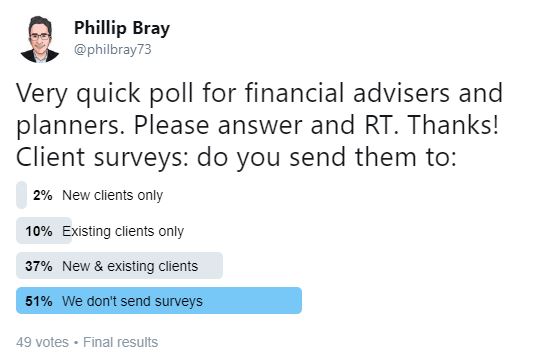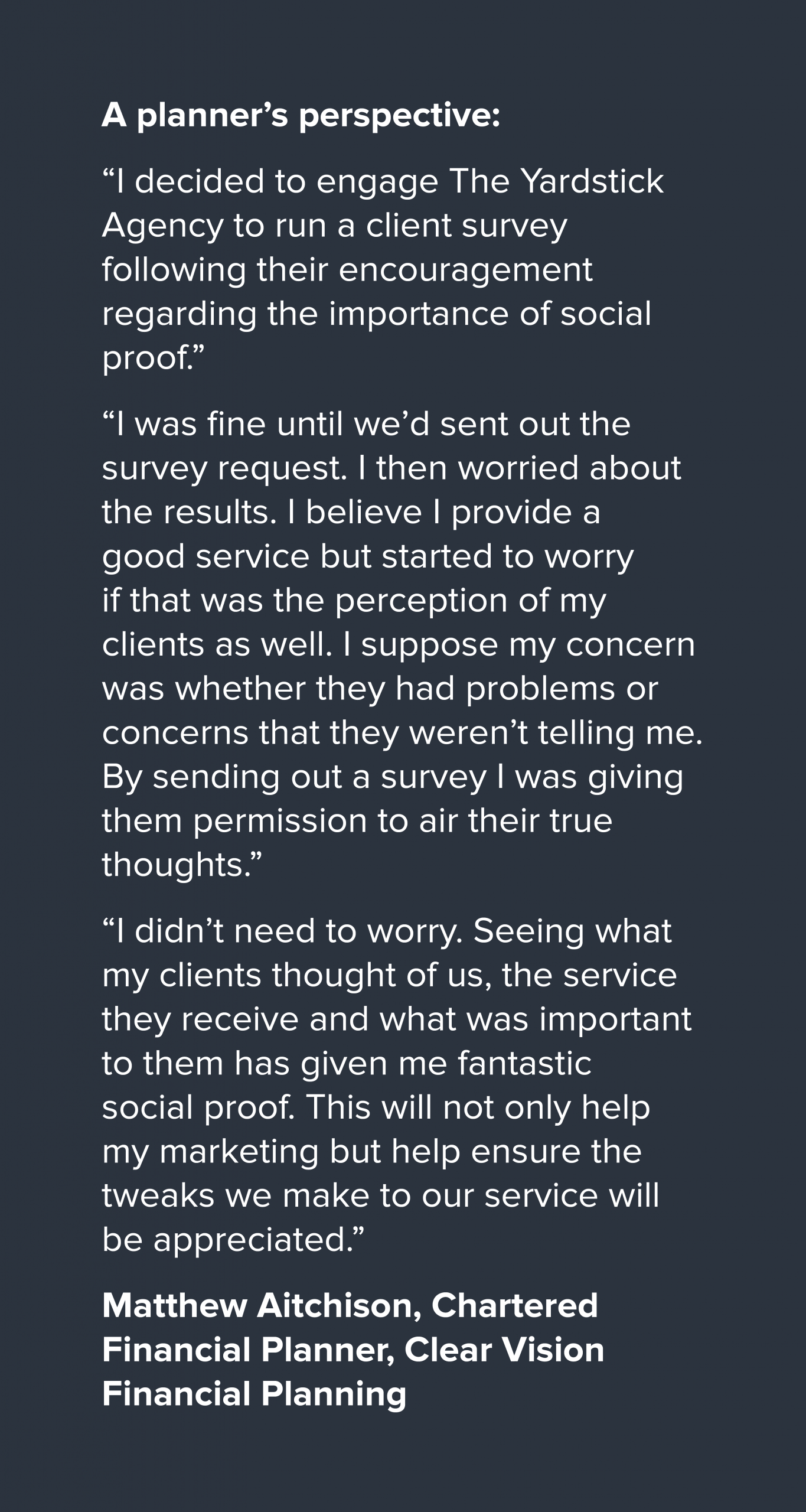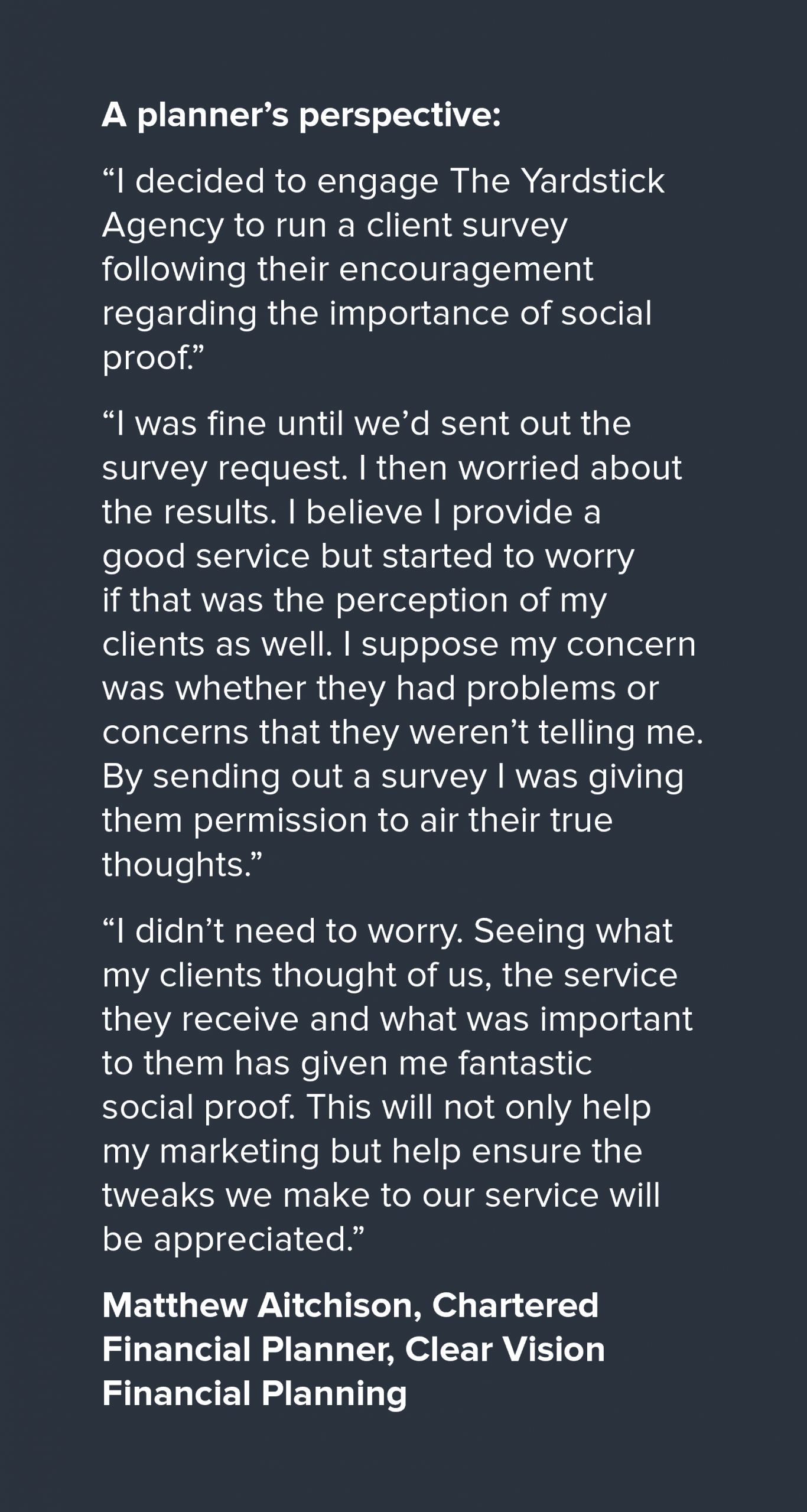In our experience, most financial advisers and planners don’t regularly survey their existing clients, a view supported by a quick Twitter poll we ran.
When we raise the subject there’s a mixture of reactions, from nervousness about what a survey might uncover, to an admission that it’s been on their to-do list for many months, but they’ve never got around to it.
We’ve also heard of some compliance departments (unbelievably) putting a stop to client surveys, worried that they might lead to an increase in complaints.
We’ve helped numerous advisers and planners survey their clients and believe there are six key ways they will help you build your business.
Understanding what your clients truly value allows you to focus your time and resources on the things which matter to them.
Take investment management. It’s labour intensive and potentially adds risk to your business, yet most clients don’t attribute significant value to it. In fact, in all the client surveys we’ve run, investment management has never featured highly in the services they most value.
1. Understand where you can improve

No one will turn down a pat on the back and client compliments are always welcome.
However, it’s the constructive feedback (and we’ve never seen anything which wasn’t constructive) that’s most valuable. No one gets it right all the time, therefore understanding where you are falling short or there’s room for improvement, is hugely beneficial, helping you improve your proposition and consequently build a better business.
2. Building your social proof (this is where we get really excited!)
Social proof; using the thoughts and words of your clients to demonstrate the value you add, is hugely important. It’s no longer good enough to say you do a great job (even though you do!).
You’ve got to prove it.
There are many ways to get the much-needed social proof including Google and VouchedFor reviews. But only client surveys allow you to pose consistent questions at a single point in time and then use the data you’ve gained on your website and in your wider marketing.
You can find an example by clicking here, to see the data on the homepage of Hunter Aitkenhead & Walker, which came directly from a client survey we ran on their behalf.
3. Understand their attitude to referring you on
We all know that referrals and recommendations are the best type of new client enquiry; they’ve already heard great things about you and to a certain extent are ‘pre-sold’ on the benefits of using you.
However, do you know how likely your existing clients are to refer you on? Without asking them, probably not.
We therefore recommend including questions in your survey to find out. Asking whether they would be happy to refer you to friends, family and work colleagues will help you understand their propensity to refer you on. And, assuming the percentage is relatively high, will give you a great statistic to add to your website.
We also advise including follow-up questions to understand the frequency with which your clients refer you on. If the answer to the first question is “yes” but that they haven’t referred you on recently, that’s telling you it’s time to go back and review your referral and recommendation strategy.
4. Requesting testimonials
A survey is the perfect time to update your client testimonials.
We recommend incorporating the text from our testimonial request email template into one of your questions. The testimonials you receive can then be used on your website and throughout your marketing.
5. Understand your client’s social media habits
Adviser: “Our clients don’t use social media.”
Me: “Have you asked them or is that an assumption?”
Adviser: “Er…fair point.”
Using the survey to ask your clients about which social media channels they use will allow you to connect with them on Facebook, Twitter, Instagram, LinkedIn etc., giving them an opportunity to see, and then share, your posts.
It will also help you understand which social media channels are used by people like them, allowing you to focus your online efforts.
6. Showing the services clients value
Understanding what your clients truly value allows you to focus your time and resources on the things which matter to them.
Take investment management. It’s labour intensive and potentially adds risk to your business, yet most clients don’t attribute significant value to it. In fact, in all the client surveys we’ve run, investment management has never featured highly in the services they most value.
And a bonus 7th…
Asking your clients how they feel about your business and the service they receive from you shows you care. As Theodore Roosevelt famously said: “People don’t care how much you know until they know how much you care”.
How and when?
We recommend sending client surveys:
- When you take on a new client, so you can understand how they view the experience
- To existing clients every year or two, so you understand their longer-term view of working with you
To help you build an effective client survey we are currently developing a checklist, telling you everything you need to do to build and run your surveys. We’ll publish that over the next couple of weeks.
In the meantime, have a think about how you view client surveys. Sure, when you click send it’s only natural to be nervous. However, the fear of a negative response is, in our experience, far from reality. Furthermore, the results will be hugely useful and we’ve no doubt they will help to grow your business. In fact, we recommend that businesses always survey their clients before embarking on a significant marketing project, such as rebuilding a website or developing a new strategy.
And, if compliance is warning you against sending the surveys, now’s the time to sit them down and explain the error of their ways!


